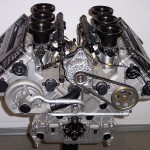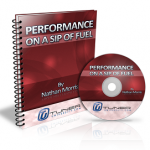 I write a lot about modifications that either don't work or work poorly but that's not to say that there aren't a whole slew of tricks that work every time.
I write a lot about modifications that either don't work or work poorly but that's not to say that there aren't a whole slew of tricks that work every time.
In this two part article, I'll explore just a few of the "tricks" and modifications you can use to increase the output of any engine without paying "gimmick tax." Gimmick tax is what you pay when you buy parts or invest in modifications that don't really work or have such small gains that they're hardly worth doing. Let's get started..
Fitting a larger exhaust than factory, always works. The key is not to go too far, but going up one or two pipe sizes will almost without exception produce more power and better overall acceleration. The reason that going to large can hurt you is that the pressure differential between the exhaust and the atmosphere at the end of the tail pipe actually helps the exhaust exit. In other words, some "pressure" (not necessarily back pressure) is good. I recently published a TU Premium exclusive article that gives a chart you can use to find the right pipe size for your exhaust system.
Increasing the compression ratio of an engine will always add power. This can be done by fitting different pistons or to a smaller degree by either milling the cylinder header or block OR installing a thinner head gasket. You may need to make slight adjustments to cam timing if you mill material off or use a thinner head gasket. As an added bonus, sometimes milling (or a thinner gasket) can unshroud the valves and increase the cylinder head's flow to a very small degree. The downside to both is you have to make sure you have adequate piston-to-valve clearance so valves do not slam into the pistons. In some modern engines, it is also not realistically possible to adjust cam timing. For example, in the 2JZ-GE engine the intake camshaft timing is not easily adjusted due to the special VVTi cam gear fitted to that engine. However, in engines like the old Honda B18C, H22, etc, the cam timing can easily be adjusted to compensate for the slight changes caused by a reduced distance from cam pulley to crank pulley.
Increased compression improves fuel economy and engine response. Be careful with compression, like anything else, it's possible to go too far and create less power (or damaging detonation) than before. The more "worked" a cylinder head, or the more modern it is, the more likely you can run higher compression. The availability of high octane fuel is another important factor.
Intake modifications work, but, no filter will make more power than a plain old factory filter, so conic filters and "high flow" filters are a waste as we've seen in previous articles. Reducing restriction by replacing the factory air box with a free flowing pipe is helpful, and if it's longer than factory it may actually help power because of it's length more so than where it locates the filter. However, the best bet is to use a differential pressure meter to find areas of restriction and keep as much of the OEM box as possible. Typically, you'll get much greater driveability and with some choice modifications, the same or more power than one of those expensive intake systems.
Changing the header design usually works as long as the new design is a good one. Factory exhaust manifolds are almost always terrible compromises and they are certainly very heavy. Most aftermarket headers shed a good bit of weight and allow exhaust gasses to be extracted from the cylinders between combustion strokes more effectively. They also usually eliminate at least one or two catalytic converters. You should always run at least one catalytic converter, and really, if the law says you have to run all of them then you really should. If you're really serious, I recommend a custom header. A proper header will actually help your engine (which is an air pump) process more air with each revolution which will produce more power. Of the classic "i/h/e" mods, the header is the only one that can radically alter airflow characteristics of your engine.
The camshafts, as Ben Strader said during a class we did together for TU Premium members (available in late June 2012), are the "brain" or the "nerve center" for your engine. Anytime you change camshafts, you are essentially making it into an entirely different engine since you're radically changing the airflow characteristics of the engine (which is an air pump). Cams with additional lift and duration will be popular choices among those seeking "all motor" gains. Typically fitting a "hotter cam" means that you'll be adding top end power while sacrificing low end power (and street manners). This is actually one of the reasons that VTEC was invented by Honda, to allow you to run a "hot" cam and a "street" cam in the same engine. In general though, fitting a camshaft built for your application (All-motor, nitrous, turbo, etc) will give you great gains. However, you will always need to then do some tuning to optimize those gains
Cylinder head work, specifically, "porting and polishing" a cylinder head is a great way to get additional power and is entirely invisible to the casual observer. Unfortunately, port work is made to be more of an art than a science and there are many more bad head porting companies/individuals than there are good ones. Look for experts with long track records and get flow sheets before and after (force some science into the mix). Porting a cylinder head is most effective when paired with higher lift cams and additional RPM, however, a good porter can optimize your cylinder head for the current RPM and lift values of your engine. The most important thing is to work with a porter who knows your exact application and is willing to work with you to create a custom piece. CNC ported heads are great if they're designed for your goals. Hand ported heads are harder to predict results but are usually what you'll find in the market place, especially for rarer applications.
Increasing engine displacement (boring/stroking) is another way to increase power. However, this will put greater demands on the cylinder head and change pretty much everything about the factory design. Piston speed and side-loading of the cylinder liners are two very important things to calculate and consider before randomly increasing the displacement of an engine. Just because a few guys out on the forums have put together a similar setup and it's stayed together for a while doesn't mean it's a good idea for your daily driven car. You'd be surprised how long a really badly put together engine will run before it finally gives up, but when it does, it's always a bad day.
Conclusion
There are other modifications out there that are worth the money, however, these are the biggies that are guaranteed to work without much danger of "gimmick tax." Gimmick tax is money you waste chasing a few horsepower here and there with silly little modifications that don't really net any big gains.
In Part II we'll talk about some additional "big win" modifications that always work, stay tuned.
Extremely Limited Time Offer - 3 Days Only
Get a MASTERS DEGREE in Performance Tuning from the BEST in the Field for ONE low package price
For 3 days only, get ALL of our PREMIUM (not available anywhere else) Tuner University Courses featuring some of the greatest minds in motorsports:
- Top 10 Performance Myths Class (MP3 and Edited Transcript) - $29.95 value
- Performance on a Sip of Fuel Class (MP3 and class manual) - $69.95 value
- Header Design Secrets with John Grudynski (MP3 and transcript) - $69.95 value
- Dirty Secrets of Oil with Ryan Stark (MP3 and transcript) - $69.95 value
- Engine Tuning Secrets with Ben Strader of EFI University (MP3 and Transcript) - $69.95 value
Get all of the above courses (many of which not currently available anywhere else) for one single price of just $309.75 $69.95. A HUGE package savings.
You can also buy any of these individually through our resource center, but I don't know why you would as this is basically the whole store for the price of just 1 course. You'll get the MP3 recordings of each class as well as a transcript or companion manual with each course and you'll be able to download them all INSTANTLY.





